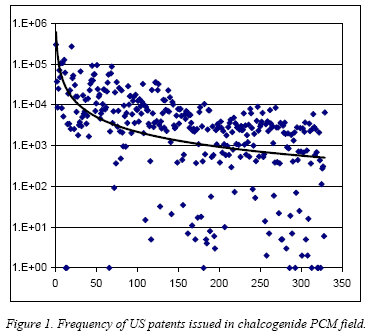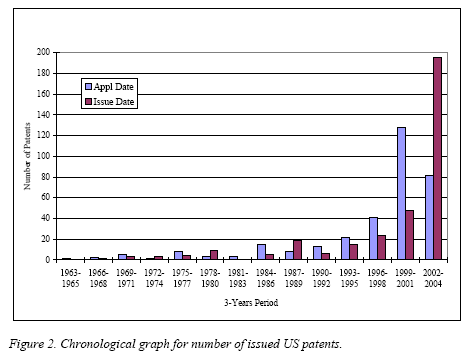Express TRIZ Analysis of US Patents in Non-volatile Phase Change Memory
Editor | On 08, Sep 2005
By: Semyon D. Savransky and Tz-Chin Wei
Semyon D. Savransky
The TRIZ Experts,
6015 Pepper Tree Court, Newark, CA 94560, USA
E-mail: TRIZExperts@hotmail.com
Tz-Chin Wei
11F, #1, Lane 228, JungAn St., JungHe City, Taipei 235, Taiwan
E-mail: peterwei@ms9.hinet.net
Abstract
The results of express patents analysis for non-volatile phase change memory in the framework of TRIZ are presented. The statistics shows that the development of non-volatile semiconductor (electrical) phase change memory occurs now at the second stage of technique evolution.
1. Introduction
The famous paper S. R. Ovshinsky [1] created a new field of non-volatile phase change memory (PCM) devices. We analyze development activities in PCM in the framework of TRIZ [2-5] .
Results of express analysis of PCM evolution trends are reported here, more detail presentations for specialists in non-volatile memory who are not familiar with TRIZ published in Ref. 6, 7.
2. US Patents in semiconductor non-volatile phase change memory field
We have analyzed US patents (from # 3,271,591 up to # 6,822,903) issued from 1966 up to November 20041 for chalcogenide PCM. In this paper we report results for more than 300 patents important for non-volatile electrical memory 2. Data shows that these patents legally issued only in one country are quite representative because most of inventors and assignees have USA jurisdiction.
The simple analysis of US patent numbers that can be performed on fly with any spreadsheet software. The analysis consists of calculation of the differences between 2 closest patents numbers for each patent under the examination. The X-axis presents linear numerical order of the patents.
There the oldest patent is marked as 1, next is marked as 2 and so on till the latest patent. Please note that this order is chronological while a query to the official US patents database (www.uspto.gov) gives patents in inverse chronological order from newest to oldest. In fact the Xaxis represents slightly uneven time scale. The “event†Y-axis shows the difference between 2 closest patent numbers in logarithmic scale (e.g., the difference between US patents 3,619,732 and 3,644,741 – which are next to each other in the field – is about 25000). The result of the analysis shows that the speed for issue of PCM patents has recently increased in about 100 times (please see the figure 1). This is indicates the transition to the second (growth) stage of the technique evolution [2,4] .
The figure 2 shows the recent explosion of activities in the field of chalcogenide phase change nonvolatile memory technology in more traditional for TRIZ coordinates [2,4] . The figure 3 illustrates patent distribution according to the top (most frequent) classes of the International Patent Classification. These 5 classes cover about 94% of all PCM patents issued in USA for the period of time under the investigation. Both figures 2 and 3 confirm the conclusion about the current second stage of technique evolution for semiconductor PCM.
The number of patent applications and the number of assignees (mostly companies participated in PCM development) also grew up from one in 1964-1974 to three in 1984-1989 to about ten at the turn of the XX century and to more than twenty in 2004. Both numbers are linearly related (figure 4). The assignee scrutiny [6,7] allows to make better decision about investing in a new technique.
We would like to stress that usually experts in a field become aware about TRIZ only at third or later stages of a technique evolution. To the best of authors’ knowledge this study is the first attempt to involve TRIZ toolbox for development of technique at early study of evolution. We hope to receive fruitful results not only for phase-change memory but for TRIZ methodology itself explore this opportunity.
3. Conclusion
We have analyzed few hundreds US patents selected in the field of PCM in the framework of TRIZ. A new express method for analysis of the stage of technique evolution proposed. The statistical results reported in this paper indicate that the semiconductor non-volatile PCM grows up presently at the second stage of the technique evolution.
References
[1] S. R. Ovshinsky, Reversible Electrical Switching Phenomena in Disordered Structures, Phys. Rev. Lett., 21, 1450 (1968).
[2] G. S. Altshuller. Creativity as an Exact Science: The Theory of the Solution of Inventive Problems, New York: Gordon and Breach, 1984.
[3] S. D. Savransky, Engineering of Creativity: Introduction to TRIZ Methodology of Inventive Problem Solving, CRC Press, 2000, 408 pp.
[4] G. G. Doncean, Y.P. Salamatov, S.D. Savransky, Theoria Evolutiei Sistemelor Technice, ROINI, 2003, 237 pp. (in Romanian).
[5] M. A. de Carvalho, S. D. Savransky, Tz-Chin Wei, 121 Heuristics for Solving Problems, LuLu, 2004, 346 pp. (ISBN: 1-4116-1689-8).
[6] S. D. Savransky and Tz-Chin Wei, Analysis of US patents (1966-Nov. 2004) in phase charge memory. 1st International Conference on Memory Technology and Design, ICMTD, France, May 2005, Paper EP-5.
[7] S. D. Savransky and Tz-Chin Wei, TRIZ analysis of US patents in Ovonic phase change memory, J. Ovonic Research, 2005, v.1 N3 (in press).






